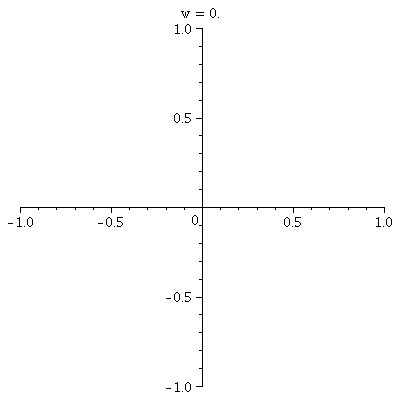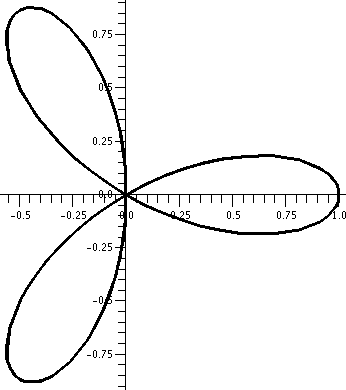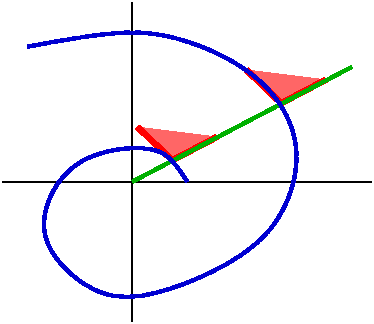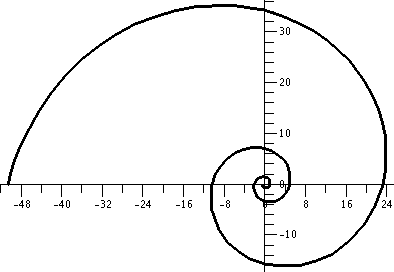Let's consider r=3+sin(θ). Since the values of sine are all between –1 and 1, r will be between 2 and 4. Any points on this curve will have distance to the origin between 2 and 4 (the green and red circles on the accompanying graph). When θ=0 (the positive x-axis) r is 3. As θ increases in a counterclockwise fashion, the value of r increases to 4 in the first quadrant. In the second quadrant, r decreases from 4 to 3. In the third quadrant, corresponding the sine's behavior (decrease from 0 to –1) r decreases from 3 to 2. In all of this {in|de}crease discussion, the geometric effect is that the distance to the origin changes. We're in a situation where the central orientation is what matters, not up or down or left or right. Finally, in the fourth quadrant r increases from 2 to 3, and since sine is periodic with period 2Π, the curve joins its earlier points.
The picture to the right shows the curve in black. I'd describe the curve as a slightly flattened circle. The flattening is barely apparent to the eye, but if you examine the numbers, the up/down diameter of the curve is 6, and the left/right diameter is 6.4.
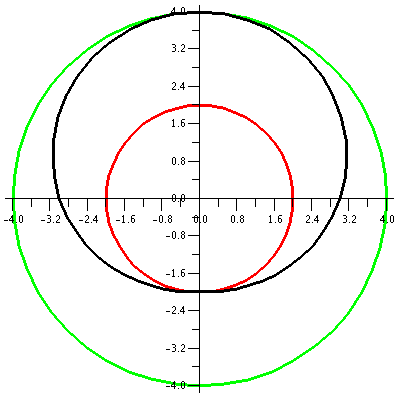
A naive person might think, "Well, I could convert the equation r=3+sin(θ) to rectangular coordinates and maybe understand it better." Except under rare circumstances (I'll show you one below), the converted equation is very irritating and difficult to understand. For example, Let's start with r=3+sin(θ) and multiply by r. The result is r2=3r+r·sin(θ). I multiplied by r so that I would get some stuff I'd recognize from the polar/rectangular conversion equations. r2 is x2+y2 and r·sin(θ) is y. So I have x2+y2=3r+y, or x2+y2–y=3r. I would rather avoid square roots so I will square this, and get (x2+y2–y)2=9r2=9(x2+y2). This is a polynomial equation in x and y of highest degree 4, defining this curve implicitly. I don't get much insight from this.
Now consider r=2+sin(θ). Again, the values of sine are all between –1 and 1, so r will be between 1 and 3. Any points on this curve will have distance to the origin between 1 and 3. We can begin (?) the curve at θ=0 when r=2, and spin around counterclockwise. The distance to the origin increases to r=3 at θ=Π/2 (the positive y-axis). The distance to the origin decreases back to r=2 when θ=Π (the negative x-axis). The curve gets closest to the origin when θ=3Π/2 (the negative y-axis) when r=1. Finally, r increases (as θ increases in the counterclockwise fashion) to r=3 again when θ=2Π.
Here the "deviation" from circularity in the curve is certainly visible. The bottom seems especially dented.
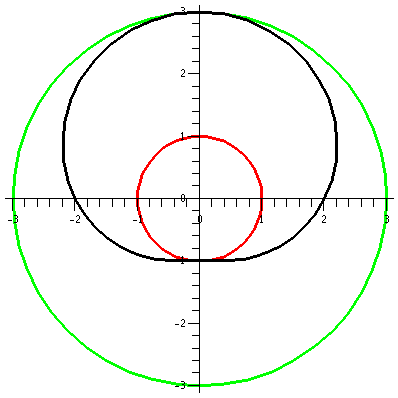
We decrease the constant a bit more, and look at r=1+sin(θ). The values of sine are all between –1 and 1, so r will be between 0 and 2. The (red) inner circle has shrunk to a point. This curve will be inside a circle of radius 2 centered at the origin. We begin our sweep of the curve at 0, when r is 1. Then r increases to 2, and the curve goes through the point (0,2). In the θ interval from Π/2 to Π, sin(θ) decreases from 1 to 0, and the curves moves closer to the origin as r decreases from 2 to 1. Something rather interesting now happens as θ travels from Π to 3Π/2 and then from 3Π/2 to 2Π.
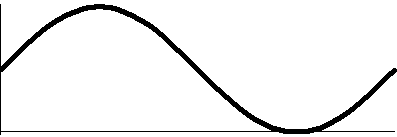 The rectangular graph of 1+sine, shown here, decreases
down to 0 and then increases to +1. The polar graph dips to 0 and then
goes back up to 1. The dip to 0 in polar form is geometrically a sharp
point! I used "!" here because I don't believe this behavior is easily
anticipated. The technical name for the behavior when r=3Π/2 is
cusp.
The rectangular graph of 1+sine, shown here, decreases
down to 0 and then increases to +1. The polar graph dips to 0 and then
goes back up to 1. The dip to 0 in polar form is geometrically a sharp
point! I used "!" here because I don't believe this behavior is easily
anticipated. The technical name for the behavior when r=3Π/2 is
cusp.
This curve is called a cardioid from the Latin for "heart" because if it is turned upside down, and if you squint a bit, maybe it sort of looks like the symbolic representation of a heart. Maybe.
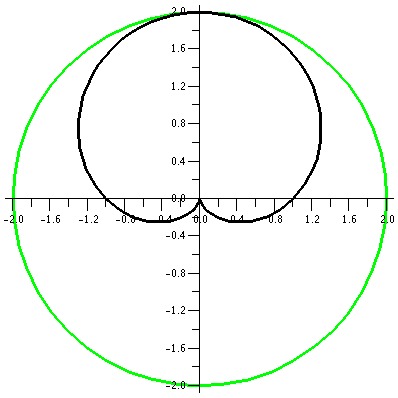
Let's consider r=1/2+sin(θ). The values of sine are all between –1 and 1, so r will be between –1/2 and 3/2. The (red) inner circle actually had "radius" –1/2, and it consists, of course, of points whose distance to the pole, (0,0), is 1/2. When θ is 0, r is 1/2. In the first two quadrants, 1/2+sin(θ) increases from 1/2 to 3/2 and then backs down to 1/2. In the second two quadrants, when θ is between Π and 2Π, more interesting things happen.
 The rectangular graph on the interval [0,2Π] of sine moved up by 1/2
shows that this function is 0 at two values, and is negative between
two values. The values are where 1/2+sin(θ)=0 or sin(θ)=–1/2. The values of θ satisfying that equation in the
interval of interest are Π+Π/6 and 2Π–Π/6. The curves goes down to
0 distance from the origin at Π+Π/6, and then r is negative until
2Π–Π/6. The natural continuation of the curve does allow negative
r's, and the curve moves "behind" the pole, making a little loop
inside the big loop. Finally, at 2Π–Π/6, the values of r become
positive, and the curve links up to the start of the big loop.
The rectangular graph on the interval [0,2Π] of sine moved up by 1/2
shows that this function is 0 at two values, and is negative between
two values. The values are where 1/2+sin(θ)=0 or sin(θ)=–1/2. The values of θ satisfying that equation in the
interval of interest are Π+Π/6 and 2Π–Π/6. The curves goes down to
0 distance from the origin at Π+Π/6, and then r is negative until
2Π–Π/6. The natural continuation of the curve does allow negative
r's, and the curve moves "behind" the pole, making a little loop
inside the big loop. Finally, at 2Π–Π/6, the values of r become
positive, and the curve links up to the start of the big loop.
This curve is called a limaçon. The blue lines are lines with θ=Π+Π/2 and θ=2Π–Π/6. These lines, for the θ values which cross the pole, are actually tangent to the curve at the crossing points.
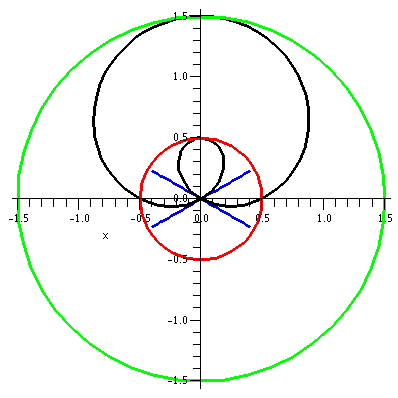
Let's try a last curve in this family, with the constant equal to 0. What does r=sin(θ) look like? A graph is shown to the right.
There are several interesting features of this graph. First, this is a polar curve which does have a nice rectangular (xy) description. If we multiply r=sin(θ) by r, we get r2=r·sin(θ), so that x2+y2=y. This is x2+y2–y=0 or, completing the square, x2+y2–2(1/2)y+(1/2)2–(1/2)2=0 so that (x–0)2+(y–1/2)2=(1/2)2. This is a circle of radius 1/2 and center (0,1/2), exactly as it looks.
The moving "picture" of this curve is quite different. Between 0 and π it spins once around the circle but then from π to 2π it goes around the circle another time! So this is really somehow two circles, even though it looks like only one geometrically.
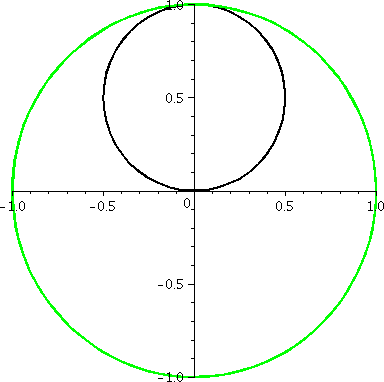
 The rectangular graph, shown here, has three pairs of ups
and downs. The polar trace covers the leaves twice. The six
up-and-downs of cos(3θ) (magically?) reduce to retracings of
half of the loops. I hope I made this evident. I
introduced some deliberate distortion in the second
tracing. (!) Without the distortion, the second tracing
could not be seen at all. The imaginary "point" travels over the
computer screen's pixels and colors them (from white to black in this
case). The second trip could not be noticed since the pixels had
already been flipped to black. So I put in a small perturbation so
that the second layer of travel could be seen.
The rectangular graph, shown here, has three pairs of ups
and downs. The polar trace covers the leaves twice. The six
up-and-downs of cos(3θ) (magically?) reduce to retracings of
half of the loops. I hope I made this evident. I
introduced some deliberate distortion in the second
tracing. (!) Without the distortion, the second tracing
could not be seen at all. The imaginary "point" travels over the
computer screen's pixels and colors them (from white to black in this
case). The second trip could not be noticed since the pixels had
already been flipped to black. So I put in a small perturbation so
that the second layer of travel could be seen.
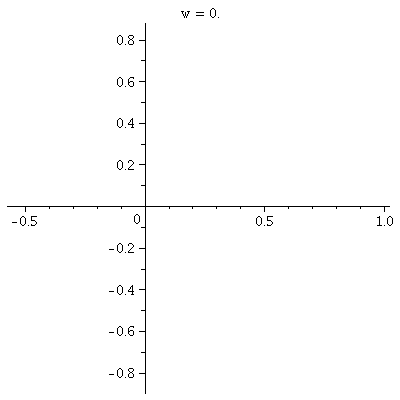
 The rectangular
graph. to the right, shows four bumps up and four bumps down. There
are no retracings of already colored points, so that the wiggles up
and down of cos(4θ) all result in 8 leaves.
The rectangular
graph. to the right, shows four bumps up and four bumps down. There
are no retracings of already colored points, so that the wiggles up
and down of cos(4θ) all result in 8 leaves.
